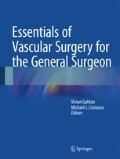Abstract
Management of blunt and penetrating trauma to the carotid and vertebral arteries has moved away from an approach focusing on operative exploration and repair to a more imaging-intensive strategy. Early CTA and a focused operative or endovascular approach can minimize the potential for missed injury and operative morbidity.
Access this chapter
Tax calculation will be finalised at checkout
Purchases are for personal use only
References
Demetriades D, Theodorou D, Cornwell E, et al. Evaluation of penetrating injuries of the neck: prospective study of 223 patients. World J Surg. 1997;21:41–7; discussion 7–8.
Roon AJ, Christensen N. Evaluation and treatment of penetrating cervical injuries. J Trauma. 1979;19:391–7.
McConnell DB, Trunkey DD. Management of penetrating trauma to the neck. Adv Surg. 1994;27:97–127.
O'Brien PJ, Cox MW. A modern approach to cervical vascular trauma. Perspect Vasc Surg Endovasc Ther. 2011;23:90–7.
American College of Surgeons. Committee on Trauma. Advanced trauma life support ATLS: student course manual. 9th ed. Chicago: American College of Surgeons; 2012.
Apffelstaedt JP, Muller R. Results of mandatory exploration for penetrating neck trauma. World J Surg. 1994;18:917–9; discussion 20.
Insull P, Adams D, Segar A, Ng A, Civil I. Is exploration mandatory in penetrating zone II neck injuries? ANZ J Surg. 2007;77:261–4.
Demetriades D, Skalkides J, Sofianos C, Melissas J, Franklin J. Carotid artery injuries: experience with 124 cases. J Trauma. 1989;29:91–4.
Willinsky RA, Taylor SM, TerBrugge K, Farb RI, Tomlinson G, Montanera W. Neurologic complications of cerebral angiography: prospective analysis of 2,899 procedures and review of the literature. Radiology. 2003;227:522–8.
Patterson BO, Holt PJ, Cleanthis M, et al. Imaging vascular trauma. Br J Surg. 2012;99:494–505.
Inaba K, Munera F, McKenney MG, et al. The nonoperative management of penetrating internal jugular vein injury. J Vasc Surg. 2006;43:77–80.
Fabian TC, Patton Jr JH, Croce MA, Minard G, Kudsk KA, Pritchard FE. Blunt carotid injury. Importance of early diagnosis and anticoagulant therapy. Ann Surg. 1996;223:513–22; discussion 22–5.
Biffl WL, Moore EE, Elliott JP, et al. The devastating potential of blunt vertebral arterial injuries. Ann Surg. 2000;231:672–81.
Biffl WL, Moore EE, Offner PJ, et al. Optimizing screening for blunt cerebrovascular injuries. Am J Surg. 1999;178:517–22.
Berne JD, Norwood SH. Blunt vertebral artery injuries in the era of computed tomographic angiographic screening: incidence and outcomes from 8,292 patients. J Trauma. 2009;67:1333–8.
Desouza RM, Crocker MJ, Haliasos N, Rennie A, Saxena A. Blunt traumatic vertebral artery injury: a clinical review. Eur Spine J. 2011;20:1405–16.
Fusco MR, Harrigan MR. Cerebrovascular dissections: a review. Part II: blunt cerebrovascular injury. Neurosurgery. 2011;68:517–30; discussion 30.
Miller PR, Fabian TC, Croce MA, et al. Prospective screening for blunt cerebrovascular injuries: analysis of diagnostic modalities and outcomes. Ann Surg. 2002;236:386–93; discussion 93–5.
Franz RW, Willette PA, Wood MJ, Wright ML, Hartman JF. A systematic review and meta-analysis of diagnostic screening criteria for blunt cerebrovascular injuries. J Am Coll Surg. 2012;214:313–27.
Bromberg WJ, Collier BC, Diebel LN, et al. Blunt cerebrovascular injury practice management guidelines: the Eastern Association for the Surgery of Trauma. J Trauma. 2010;68:471–7.
Biffl WL, Cothren CC, Moore EE, et al. Western Trauma Association critical decisions in trauma: screening for and treatment of blunt cerebrovascular injuries. J Trauma. 2009;67:1150–3.
Eastman AL, Muraliraj V, Sperry JL, Minei JP. CTA-based screening reduces time to diagnosis and stroke rate in blunt cervical vascular injury. J Trauma. 2009;67:551–6; discussion 5–6.
Biffl WL, Moore EE, Offner PJ. Blunt carotid arterial injuries: implications of a new grading scale. J Trauma. 1999;47:845.
Cothren CC, Moore EE, Biffl WL, et al. Anticoagulation is the gold standard therapy for blunt carotid injuries to reduce stroke rate. Arch Surg. 2004;139:540–5.
Bradley EL. Management of penetrating carotid artery injuries. An alternative approach. J Trauma. 1973;13:248–55.
Thal ER, Snyder WH, et al. Management of carotid artery injuries. Surgery. 1974;76:955–62.
Thomas GI, Anderson KN, Hain RF. The significance of anomalous vertebral-basilar artery communications in operation on the heart and great vessels. Surgery. 1959;46:747–57.
du Toit DF, van Schalkwyk GD, Wadee SA, Warren BL. Neurologic outcome after penetrating extracranial arterial trauma. J Vasc Surg. 2003;38:257–62.
Nair R, Robbs JV, Muckart DJ. Management of penetrating cervicomediastinal venous trauma. Eur J Vasc Endovasc Surg. 2000;19:65–9.
Rich NM, Collins Jr GJ, Andersen CA, et al. Venous trauma: successful venous reconstruction remains an interesting challenge. Am J Surg. 1977;134(2):226–30.
Author information
Authors and Affiliations
Corresponding author
Editor information
Editors and Affiliations
Rights and permissions
Copyright information
© 2015 Springer Science+Business Media New York
About this chapter
Cite this chapter
Schechter, M.A., O’Brien, P.J., Cox, M.W. (2015). Vascular Injuries in the Neck. In: Gahtan, V., Costanza, M. (eds) Essentials of Vascular Surgery for the General Surgeon. Springer, New York, NY. https://doi.org/10.1007/978-1-4939-1326-8_14
Download citation
DOI: https://doi.org/10.1007/978-1-4939-1326-8_14
Published:
Publisher Name: Springer, New York, NY
Print ISBN: 978-1-4939-1325-1
Online ISBN: 978-1-4939-1326-8
eBook Packages: MedicineMedicine (R0)

